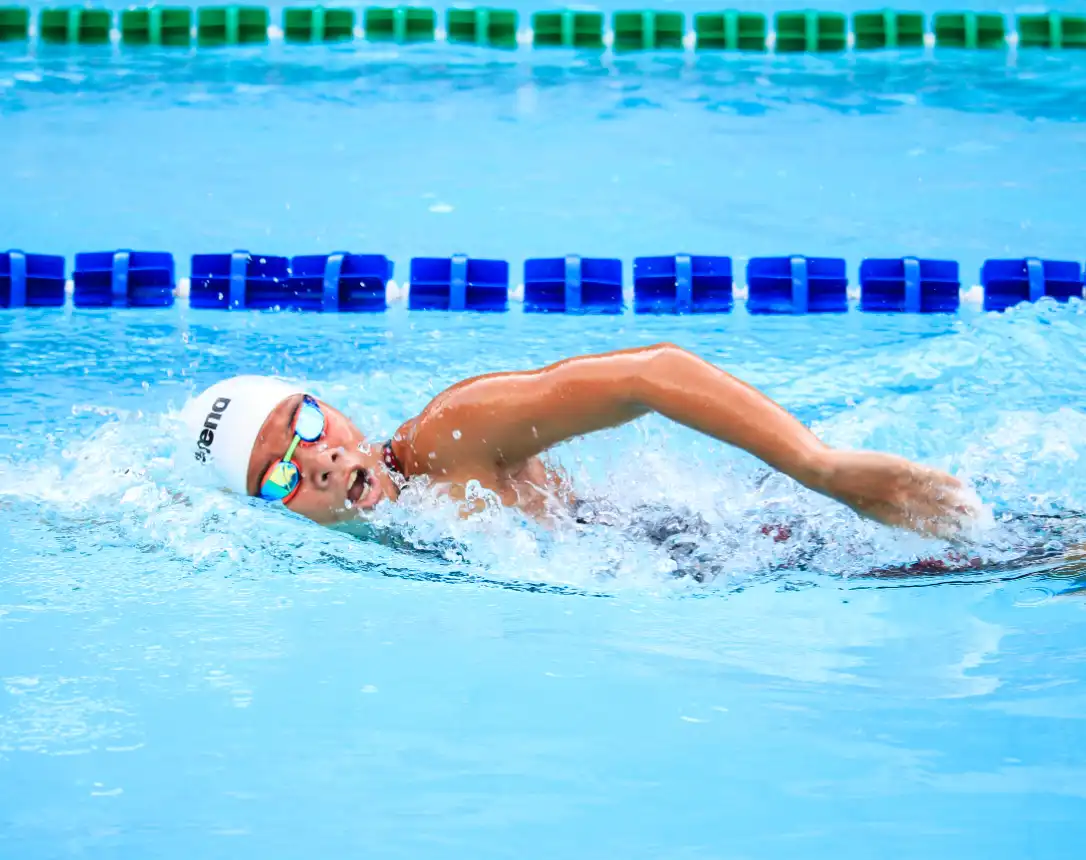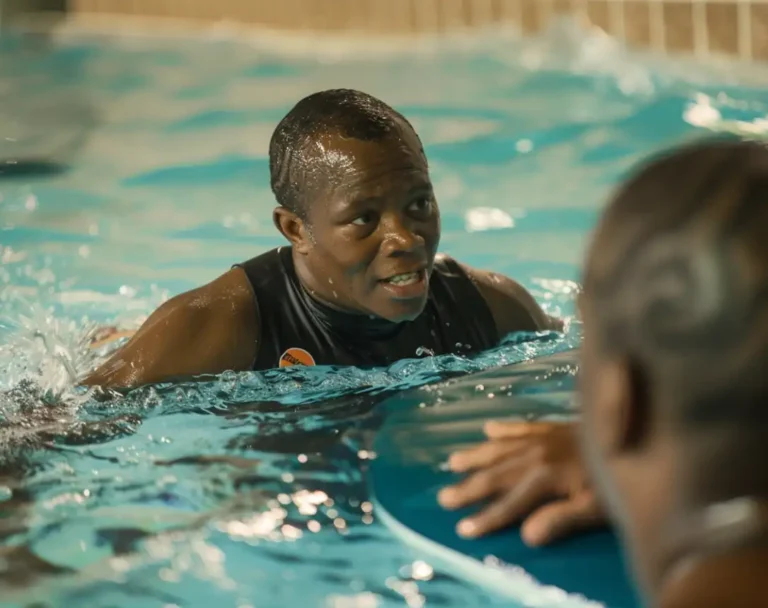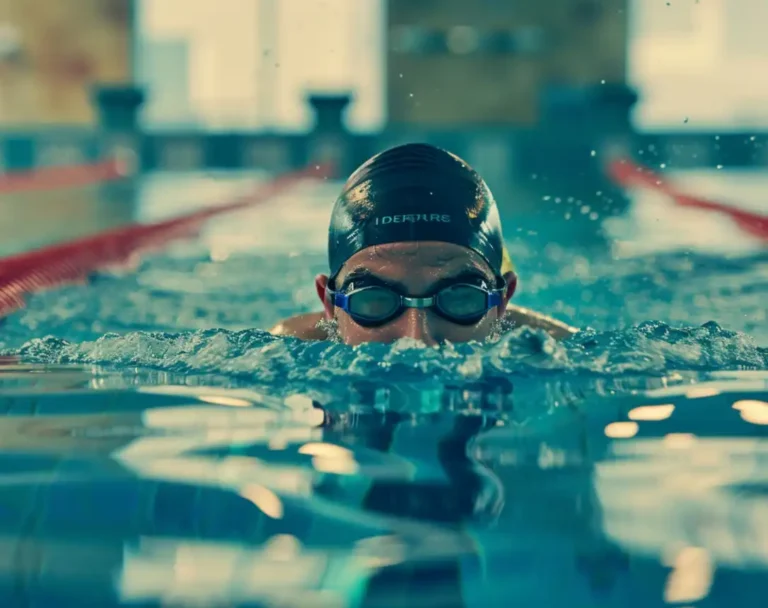Inhaling and exhaling may appear to be the simplest of processes, yet it transforms completely when you’re cutting through the waves. It goes beyond merely panting for breath; mastering how to breathe correctly can elevate your swim technique, increase stamina, and assist in keeping a consistent pace in the water. Adding targeted breathing drills for swimmers to your practice could be the key to upgrading your performance.

In swimming, a well-executed breath is the subtle difference between struggling to complete a lap and gliding through your strokes with ease. Whether you’re a competitive swimmer aiming for personal bests or someone who enjoys a few leisurely laps at the local pool, knowing how to control your breath has benefits beyond measure. Fortunately, there are both dryland and in-pool exercises to help you master this aquatic art.
It’s not just about training your muscles and building endurance, it’s about teaching your lungs to be as efficient as possible. When you consciously practice breathing techniques, you’re equipping your body to deal with the demands of the sport. So, let’s dive into the realm of breath control – because if swimming is part melody, rhythm, and motion, then breath is unquestionably the beat that ties it all together.
Basics of Breathing Exercises for Swimming
When you’re in the water, breathing isn’t just about keeping oxygen flowing to your muscles; it’s also key for maintaining balance and rhythm in your strokes. Here’s how to get the basics right:
- Face in the Water: Keep your face submerged and turn it to the side to breathe as part of your stroke cycle. Your mouth should clear the water, not by lifting your head but by rotating it within the axis of your stroke. Learn the right timing.
- Bilateral Breathing: Try to alternate the sides you breathe on to maintain symmetry in your stroke. This can prevent muscle imbalances and help you swim in a straight line.
- Inhale Quickly, Exhale Slowly: You need to master the art of quick inhalation. Once your head is turned, inhale sharply through your mouth before your face re-enters the water. Exhale gradually through your nose while your face is in the water, readying your lungs to take fresh air on the next cycle.
- Relaxation: Keep calm and avoid holding your breath underwater. Tension can lead to quicker fatigue and inefficient swimming.
The following table summarizes the key points of breathing exercises for swimming:
| Action | Details |
|---|---|
| Face Position | Submerged with side rotation for breathing |
| Breathing Technique | Bilateral to keep strokes balanced |
| Inhalation | Quick, through the mouth |
| Exhalation | Slow, through the nose while submerged |
| State of Mind | Relaxed, avoiding breath holding |
Remember, it’s not just about the act of breathing, but how it integrates with your swimming. Practice skills like breath control and rhythm by incorporating targeted exercises into your routine. With time, you’ll feel more comfortable and efficient in the water.
Breathing Techniques for Different Strokes

Each swim stroke has its own unique breathing technique. Mastering these will help you swim more efficiently and improve your overall performance. Try this breathing exercises for swimming.
Freestyle Breathing
In the freestyle stroke, you typically breathe every three strokes, turning your head to the side just before your arm exits the water. Make sure to exhale underwater so you can inhale quickly and smoothly during your turn.
Breaststroke Breathing
With breaststroke swimming, timing is key. You’ll want to breathe every stroke by lifting your head up during the in-sweep phase of your arms. Practice a quick inhale before ducking back down to glide.
Butterfly Stroke Breathing
During the butterfly, breathe by bringing your head just above the water’s surface as your arms come forward. It’s important to keep this motion fluid to maintain momentum and avoid excessive drag.
Backstroke Breathing
Since your face is above water in the backstroke, you can breathe normally. Focus on maintaining a rhythmic breathing pattern in sync with your stroke to avoid unnecessary tension in your body.
Diaphragmatic Breathing Exercises for Swimmers
Why Try It: Diaphragmatic breathing can be particularly beneficial for you as a swimmer to improve oxygen intake, which, in turn, can enhance endurance and performance.
How It’s Done:
- Get Comfortable: Start by lying on your back with your knees bent. Place one hand on your upper chest and the other just below your rib cage. This will allow you to feel your diaphragm move as you breathe.
- Breathe In Slowly: Take a slow and deep breath in through your nose, ensuring that your stomach moves outward against your hand. The hand on your chest should remain as still as possible.
- Tighten Your Muscles: Tighten your stomach muscles, letting them fall inward as you exhale through pursed lips. The hand on your upper chest must still remain still.
Frequency & Duration: Begin with 5-10 minutes, 1-2 times a day. You can gradually increase the duration as your diaphragm gets stronger.
Tips to Remember:
- Practice Makes Perfect: Like any skill, diaphragmatic breathing becomes more natural the more you practice it.
- Consistency is Key: Try to incorporate this exercise into your daily routine.
- During Practice: Use this breathing technique during your swim warm-ups to get into the rhythm.
Transferring Skills to the Pool: Once you’re comfortable performing diaphragmatic breathing on land, try applying it to your swimming breathing technique. Focus on using your diaphragm to control your breath as you swim, which can help you maintain a steady pace and rhythm in the water.
Rhythmic Breathing Patterns
When you’re in the water, establishing a consistent breathing rhythm is crucial. It’s about syncing your breaths with your strokes to maintain efficiency and endurance while swimming.
Here’s a simple pattern to start with:
- One Side Breathing: Breathe every two strokes, all on the same side. This method builds stamina and gets you accustomed to longer bouts of holding your breath.
But what if you need a change? Mix it up!
- Bilateral Breathing: Breathe every three strokes, alternating sides. This not only helps balance your stroke but can also improve navigation in open water swims. It might feel odd at first, but practice makes perfect.
Remember these tips:
- Inhale quickly through your mouth when turning your head to the side.
- Exhale slowly and steadily underwater through your nose or mouth.
- Keep your head aligned with your spine to avoid strain.
| Stroke Count | Breathing Side |
|---|---|
| 2 | Left/Right |
| 3 | Alternating |
Maintain focus, and soon these patterns will feel like second nature. Your body will thank you as you glide through the water with less effort and more control over your breath.
Breath Control and Endurance Training
Mastering breath control is essential for boosting your endurance in the water. When you improve how you control your breathing, you can swim longer and more efficiently.
Hypoxic Training
Hypoxic training involves limiting your oxygen intake during swimming. It’s a technique that teaches your body to use oxygen more effectively and increases your ability to swim longer distances without getting breathless. Start with sets like 4 x 25s with a gradually decreasing number of breaths. Be cautious; hypoxic training should be done under supervision.
Continuous Breathing Drills
Continuous breathing drills help you get comfortable with exhaling underwater and finding a rhythm in your breath. A simple drill is to swim a few laps focusing solely on your exhale, ensuring it’s steady and controlled. For swim workouts that target your endurance and breathing, visit YourSwimLog. Remember, the goal is to establish a pattern that syncs up with your stroke.
Breathing Exercises for Relaxation
Incorporating breathing exercises for swimming into your training can help you relax both mentally and physically. Focusing on your breath reduces stress and prepares you to swim with ease.
Deep Breathing Methods
Begin practicing deep breathing by finding a comfortable place to sit or lie down. Inhale slowly through your nose, allowing your stomach to expand, and then exhale gently through your mouth. Aim for extended breaths each time you inhale and exhale, gradually working up to a count of five for each. Practicing this routine can greatly help in maintaining a calm and focused state during your swims.
Visualization Techniques
While practicing your deep breathing, add visualization to enhance relaxation. Picture yourself gliding effortlessly through the water with each breath. Imagine the sensation of water passing by with every stroke and dive, aligning your breath with the rhythm of your movements. This mental rehearsal can translate into improved comfort and technique in the water.
Pre-Swim Breathing Warm-Ups
Before you dive into the water, warming up your lungs can be just as important as stretching your muscles. Breathing exercises for swimming can help increase lung capacity, control, and oxygen flow.
Box Breathing:
Get comfortable and try to relax your body.
- Inhale for 4 seconds
- Hold your breath for 4 seconds
- Exhale for 4 seconds
- Hold your breath again for 4 seconds
Repeat this cycle for a few minutes to help center your breath and focus. This technique can also help control your emotional energy during a swim.
Bilateral Breathing:
By practicing bilateral breathing out of the water, you’ll be better prepared when you’re doing freestyle.
- Take a breath every three strokes, alternating sides
- Try to keep your breaths even and relaxed
This exercise will help you get used to the rhythm you’ll use while swimming.
Diaphragmatic Breathing: Place one hand on your chest and the other on your belly. Focus on breathing deeply into your belly rather than your chest, which can enhance your overall breathing efficiency.
- Breathe in deeply through your nose, feeling your belly rise
- Exhale slowly through pursed lips, feeling your belly fall
Doing this for a few minutes can help activate your diaphragm, the muscle that should do most of the work when you’re breathing while swimming.
These exercises can ensure a steady swimming performance with proper oxygen delivery to your muscles. Remember to keep these exercises regular in your swim routine so you can keep your breathing controlled and efficient.
10 quick breathing exercises for swimming
- Deep Breathing: Inhale deeply through your nose, hold for 3 seconds, exhale through mouth. Repeat 10 times.
- Side Breathing: Stand with feet shoulder-width apart, breathe in through one side, out the other. Switch sides with each breath.
- Diaphragmatic Breathing: Lay down, place hand on belly, breathe deep into belly to engage diaphragm.
- Pursed Lip Breathing: Exhale through pursed lips like blowing on hot soup. Controls exhale pace.
- Alternate Nostril Breathing: Use finger to close alternate nostrils while inhaling/exhaling slowly and deeply.
- Jogging Breaths: While jogging in place, breathe in for 3 steps, out for 3.
- Underwater Breathing: Practice controlled breathing under water against a wall.
- Bilateral Breathing: Practice side breathing in shallow water by rotating head to breathe on alternate sides.
- Swim Breathing: Swim laps focusing on exhaling fully before the next breath.
- Paced Breathing: Swim with breath every 3rd stroke, timing inhales and exhales with strokes.
Post-Swim Breathing Cool-Downs

After a long swimming session, it’s super crucial to let your body wind down. Breathing exercises for swimming are perfect for this. Not only do they help regulate your oxygen flow, but they also ease you into a state of relaxation. Here’s a quick guide to post-swim breathing cool-downs that you should try!
- Box Breathing: This technique has you breathing in a controlled pattern that resembles the sides of a box. According to SwimCompetitive.Com, practice breathing in for 5 seconds, holding for 5 seconds, breathing out for 5 seconds, and then holding again for 5 seconds. Repeat this cycle several times until you feel your heart rate slowing down.
- Wall Calf Stretch: As suggested by Playo, stand a foot away from a wall. Position the leg you want to stretch behind you and lean forward with your other leg. Keep the heels grounded and hold the stretch for 30 seconds on each side. During the stretch, focus on steady breathing to aid muscle relaxation.
The key to a successful cool-down is to keep your breathing even and consistent:
| Breathing Technique | Duration | Focus |
|---|---|---|
| Box Breathing | 5-5-5-5 | Evenness and consistency |
| Wall Calf Stretch | 30 sec | Steady breathing with stretching |
These exercises are perfect for easing your transition from high-intensity workout to rest. Remember to maintain a steady rhythm—cooling down is as important as the swim itself. So take a moment, breathe deeply, and give your body the post-swim care it deserves.
How can I improve my breathing for swimming?
Practicing breathing exercises for swimming on land is a great way to improve your breathing for swimming. Try side breathing while walking or jogging to build lung capacity and breath control.
What are the best breathing techniques for open water swimming?
For open water swimming, breathing techniques for swimming involve bilateral breathing. Take breaths on both sides by rotating your head to breathe every few strokes on alternate sides. This allows visibility on both sides.
How many breaths should you take when swimming?
Most swimmers take a breath every 1-3 strokes depending on stroke and intensity. Taking 2 breaths per 3 strokes is a general guideline for recreational and fitness swimming. Faster swimmers may breathe every stroke.
Do you breathe through your mouth or nose when swimming?
It is best to breathe through your mouth when swimming as it allows more air intake than breathing through your nose. Nose breathing is difficult to coordinate with the swimming rhythm. Mouth breathing exercises for swimming are most effective.
If you liked my blog post about the breathing exercises for swimmers, don’t forget to leave us a comment down below to tell us about your experience with it.






